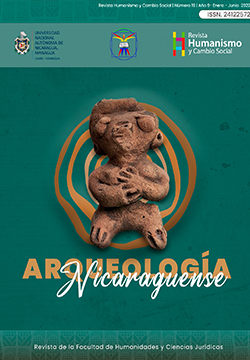Alcoholics Anonymous: a religious community that generates identity
DOI:
https://doi.org/10.5377/hcs.v19i19.14124Keywords:
Religious community, identity, Alcoholics Anonymous, MexicoAbstract
The purpose of this article is to describe and analyze how the Alcoholics Anonymous religious therapeutic community generates identity among the members of the group. Based on the experience in the fi eld and offi ce work, it was reflected on the various aspects that make up the social phenomenon regarding the way in which Alcoholics Anonymous works. Among the most outstanding results, we find that Alcoholics Anonymous is a community of men and of alcoholism in Mexico, there are Civil Associations among which Alcoholics Anonymous stands out. Although the religious therapeutic method of Alcoholics Anonymous does not guarantee the rehabilitation of alcoholism, the community does operate as a religious group for self-help and mutual help in the face of social problems presented by members of the community. women that works through a religious therapeutic model called the Three Legacies, through which it indoctrinates the members, who acquire cultural patterns that make them fully identify with the grouping. It can be inferred that the ingestion of intoxicating beverages is a generalized contemporary practice that is increasing among the population in Mexico. To address this social problem of alcoholism in Mexico, there are Civil Associations among which Alcoholics Anonymous stands out. Although the religious therapeutic method of Alcoholics Anonymous does not guarantee the rehabilitation of alcoholism, the community does operate as a religious group for self-help and mutual help in the face of social problems presented by members of the community.
Downloads
1092
References
Alcohólicos Anónimos (2006). Manual de servicios de Alcohólicos Anónimos y doce conceptos para el servicio mundial. México: Alcohólicos Anónimos.
Alcohólicos Anónimos (2005a). Este es el libro grande, el texto básico de Alcohólicos Anónimos. México: Alcohólicos Anónimos.
Alcohólicos Anónimos (2005b). Llegamos a creer. México. Alcohólicos Anónimos.
Alcohólicos Anónimos (2005c). Esto es A.A. México: Alcohólicos Anónimos.
Alcohólicos Anónimos (2002). Información general de A.A. México: Alcohólicos Anónimos.
Armando (2017, febrero 9). Entrevista realizada en la casa del A.A. Armando (Mp3), Villahemrosa, Tabasco, México.
Barfield, T. (2000). Diccionario de antropología. México: Siglo XXI.
Blancarte, R. (1993). Historia de la iglesia católica en México 1929-1982. México: Fondo de Cultura Económica, El Colegio Mexiquense.
Dubet, F. (2006). El declive de la institución. Profesiones, sujetos e individuos ante la reforma del Estado. España: Gedisa.
Durkheim, É. (1997). La educación moral. México: Colofón.
Durkheim, É. (1992). Las formas elementales de la vida religiosa. México: Colofón.
Durkheim, É. (1990). Educación y sociología. España: Ediciones Península.
Durkheim, É. (1976). Educación como socialización. España: Ediciones Sígueme.
García, N. (1995). Consumidores y ciudadanos: confl ictos multiculturales de la globalización. México: Grijalbo.
García, N. (1990). Culturas Híbridas: estrategias para entrar y salir de la modernidad. México: Grijalbo.
Gutiérrez, Á. A. (2020). La ingesta de alcohol y su rehabilitación en México. Cultura y Droga, 25(29), 141-162. Recuperado de: https://revistasojs.ucaldas.edu.co/index.php/culturaydroga/article/view/2241
Gutiérrez, Á. A. (2019). Alcohol. De elixir de los dioses al consumo consuetudinario. México: Universidad Juárez Autónoma de Tabasco. Recuperado de: https://doi.org/10.19136/book.128
Gutiérrez, Á. A. (2018). Epiméleia socrática: modelo terapéutico de Drogadictos Anónimos en Villahermosa, Tabasco, México. Drugs and Addictive Behavior, 3(1), 75-91. Recuperado de: https://doi.org/10.21501/24631779.2636
Gutiérrez, Á. A. (2017). Asoc iaciones Civiles que atienden a usuarios de drogas en Villahermosa, Tabasco. Espacio. Innovación más Desarrollo, 6(15), 100-124. Recuperado de: https://doi.org/10.31644/IMASD.15.2017.a06
Gutiérrez, Á. A. (2015). El método terapéutico religioso de Alcohólicos Anónimos. Ciencias Sociales y Religión, 17(22), 188-200. Recuperado de: https://doi.org/10.22456/1982-2650.53492
Gutiérrez, Á. A. (2014). Purifi cando almas: Alcohólicos Anónimos en Bacalar, Carlos A. Madrazo y Ramonal, Quintana Roo. México: Universidad Nacional Autónoma de México. Recuperado de:
https://repositorio.unam.mx/contenidos/97823
Palomo, M. (2001). Libros de cofradías: una opción metodológica. Pueblos y Fronteras, Tomo I. México: Universidad Nacional Autónoma de México.
Pérez, R. (1997). Hábitos, normas y escandalo: prensa, criminalidad y drogas durante el Porfiriato tardío.México: Centro de Investigaciones y Estudios Superiores en Antropología Social.
Salles, V. y Valenzuela, J. M. (1997). En muchos lugares y todos los días. Vírgenes, santos y niños dios. Mística y religiosidad popular en Xochimilco. México: El Colegio de México.
Touraine, A. (2005). Un nuevo paradigma para comprender el mundo hoy. España: Paidós. Weber, M. (1985). Economía y sociedad. México: Fondo de Cultura Económica.
Downloads
Published
How to Cite
Issue
Section
License
Copyright (c) 2022 Universidad Nacional Autónoma de Nicaragua, UNAN-Managua

This work is licensed under a Creative Commons Attribution-NonCommercial-ShareAlike 4.0 International License.




